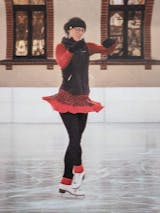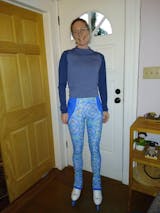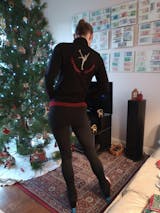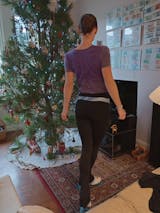Before you open any printed pattern, most people first turn the envelope over to look at the back of the envelope, right after looking at the cover photo. If you purchased a downloadable (PDF) pattern, you will find that information in the Instruction package.
When looking at a the back of a Jalie patterm for the first time, you might be a bit overwhelmed for various reasons:
-
French and English coexist on the same page (and English is not listed first)
- Both metric and imperial units are used (for measurements and yardage)
- There is usually over 20 sizes on the pattern (up to 28 sizes in one pattern!)
Don't worry, you'll get used to it :)
Let's break it down together:
A: Pattern General Information
You will always find the pattern number, name and description at the top. At the bottom, you will always see the pattern pieces, line drawing showing the views included.
B: Body Measurements
We work very hard to have good fitting garments that fit true to the Jalie size. The
Jalie size is a letter, not a number. We did that on purpose to make sure people take a few minutes to take their body measurements. RTW size or age provides an ok estimate, but for a good fit (which is probably one of the reasons why you are sewing rather than buying clothes off the rack), you need to know the body measurements in order to prick the proper size.
In most recent patterns, we put the most important one in
red. In all patterns, we also include that information at the very beginning of the sewing instructions (bust for
tops, hips for
bottoms and girth for
swimsuits and
leotards, etc).
All the sizes you see there is what the pattern includes. You do NOT need to pick a size when buying the pattern. You get them all! Both printed and
PDF patterns come with all the sizes you see in the chart. This means that, once you have your pattern, you can make a garment again and again for kids and adults of all shapes and sizes!
C: Yardage
That is the amount of fabric you need, in yard and meters. It is sometimes listed per view or per section (if there is color blocking) or by fabric width. Look closely on the left to identify the correct label for the correct fabric.
If notions are required, you will find them listed, by size group, in the bottom of the page (bottom right corner usually ;))
D: Fabric Info
We always provide a brief description of the type of fabric recommended for the pattern. Those are fabrics we most probably tested and / or know they will work. We do not include all fabrics under the sun so if you find a mysterious fabric with a funky name that feels right (because it feels like another knit top you own or drapes like the garment on the cover photo, it's ok. Trust your sewing instinct. Just make sure it has the correct amount of stretch if it's a pattern with a stretch requirement guide.
Speaking of
fabric stretch, it means the percentage by how much it stretches, NOT the spandex content. You need to hold a fold of fabric, a few inches away from selvage, position your fingers on the ruler and stretch EASILY to the end of the ruler. You could also do the math and hold 10cm (or 10inches) and looking at the final length you get when stretched comfortably. If the fabric calls for 60% stretch, it means it has to stretch from 10 to 16 (10 + 60%).
E: Seam allowance info
Even though the seam allowance is indicated in the instructions, we always listed on the back as well as some people may not feel comfortable working with patterns that have a seam allowance narrower than the 5/8'' they are used to. Seam and hem allowances are ALWAYS included in the pattern. You don't need to add anything. You can cut and sew without the need for an extra coffee or special ruler :)












